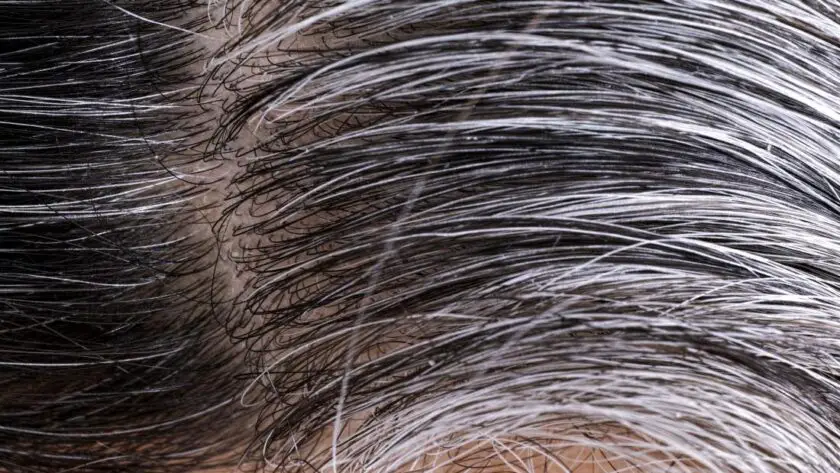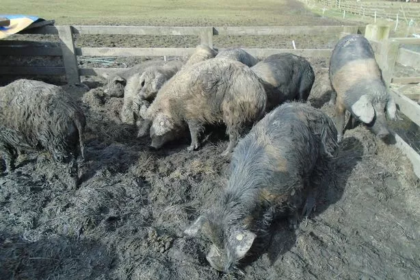Gray and silver locks are often seen as a sign of wisdom and experience that comes with age. However, some may wish to slow down or even reverse the graying process to hold on to their natural hair color for longer.
In a recent video, Dr. Eric Berg, a chiropractor and expert on nutrition and natural health, explains how certain foods and nutrients can help combat graying hair. He provides science-backed information on the causes of gray hair and how diet and lifestyle changes may help preserve youthful locks.
Dr. Berg’s nutritional advice focuses on getting adequate amounts of key vitamins, minerals, and other compounds that play a role in hair pigmentation. While gray hair is a natural part of aging, Dr. Berg’s tips may help men and women nurture healthier hair and potentially slow down the march to salt-and-pepper tresses.
Fighting Back Against Premature Gray Hair
Graying hair is often seen as a distinguishing mark of wisdom and experience that naturally comes with advancing age. However, more young men and women are grappling with premature graying before age 30 due to nutritional deficiencies and lifestyle stressors.
Recent scientific insights into the underlying biology of hair pigmentation reveal how certain dietary choices and supplements may help nourish hair follicles and preserve youthful locks longer.
The Natural Process of Graying Over Time
Hair color is produced by pigment-generating melanocytes that reside within each hair follicle. These melanocytes synthesize the pigment melanin that gives hair its natural coloration ranging from blonde to black.
As we age, melanocyte activity slows, resulting in reduced melanin output. With less melanin available, hair gradually turns gray and eventually white. People typically begin graying in their 30s or 40s, with 50% having at least 50% gray hair by 50 years old.
For many, gray strands are seen as distinguished badges of honor reflecting maturity and wisdom gained through the years. However, premature graying before age 30 is increasingly common and suggests other factors are accelerating the aging of hair pigment.
Recent science shows that graying is not just about chronological age. Nutritional deficiencies, chronic stress, and other lifestyle influences can deplete hair color despite still being relatively young.
Understanding the Biochemical Process Behind Gray Hair
To understand how to slow or reverse premature graying, it helps to dive into the biochemistry of melanin synthesis in hair follicles. Two key players are the trace mineral copper and an enzyme called tyrosinase.
Tyrosinase kick starts the chain of chemical reactions that convert amino acids like tyrosine into melanin pigments. However, tyrosinase critically depends on copper to function properly and catalyze melanin production.
Copper serves as an essential cofactor that allows tyrosinase to drive melanin synthesis. When the body becomes deficient in copper, tyrosinase loses its ability to stimulate melanocytes to make melanin. The end result is gray hair even at an early age.
How Chronic Stress Depletes Copper
Stress has become a major culprit behind rising rates of premature graying. When under prolonged stress, the adrenal glands ramp up production of the hormone cortisol.
Although cortisol helps mobilize energy reserves to deal with stress, chronically elevated levels accelerate aging and deterioration throughout the body.
Making cortisol requires multiple copper-dependent enzymes. So sustained stress drains copper stores as more gets shunted to increased cortisol output.
With copper reserves diminished, there is inadequate copper available to provide tyrosinase with the copper it needs to catalyze melanin synthesis. This stress-induced copper drain is likely a driving factor in premature graying.
Hydrogen Peroxide Buildup Also Contributes to Graying
In addition to insufficient melanin, aging hair follicles accumulate hydrogen peroxide over time. Hydrogen peroxide is a reactive pro-oxidant molecule that inflicts oxidative damage.
As hydrogen peroxide levels rise in hair follicles, it has a bleaching effect that strips away hair pigment. An enzyme called catalase breaks hydrogen peroxide down into harmless water and oxygen.
However, catalase activity also declines with age, allowing hydrogen peroxide to accumulate unchecked. This escalation of hydrogen peroxide accelerates the graying process by damaging melanocytes.
Low-grade chronic infections further add to hydrogen peroxide overload. White blood cells generate hydrogen peroxide to fight pathogens. Lingering infections & immune disorders translate to persistently high hydrogen peroxide that can bleach hair from the inside out.
How to Ward Off Premature Graying
While some graying is inevitable with aging, emerging science shows nutrition and lifestyle changes can help maintain natural hair color for longer.
Strategies to nourish hair pigment center around getting adequate copper, reducing stress, and increasing catalase intake.
-
Eat More Copper-Rich Foods
Consuming foods high in bioavailable copper provides the raw material needed for tyrosinase activity and melanin production. Foods naturally abundant in copper include:
- Organ meats like beef liver (from grass-fed cows)
- Oysters and mussels (sustainably harvested)
- Soybeans, lentils, nuts (organic)
- Shiitake mushrooms
- Dark chocolate (fair trade)
- Avocados
- Spinach and other leafy greens (organic)
-
Reduce Stress Through Lifestyle Changes
Cutting down stress limits cortisol release and copper depletion. Ways to mitigate stress include regular exercise, meditation, gratitude journals, yoga, and adequate sleep. Avoiding smoking, excess alcohol, and drugs can further help maintain lower stress for hair health.
-
Load Up on Catalase-Rich Foods
Eating foods high in catalase introduces more of this antioxidant enzyme to break down hydrogen peroxide before it damages hair follicles. The most potent catalase sources include:
- Organ meats like liver and kidney (from grass-fed cows)
- Fatty fish like salmon and mackerel (sustainably caught)
- Poultry like chicken, turkey, and eggs (free range)
- Cruciferous vegetables
- Milk products (organic)
-
Consider Adding Spirulina To Your Daily Regimen
Spirulina is a type of blue-green algae that has emerged as a superfood packed with nutrients that combat aging. Adding spirulina to your daily diet or supplements routine can provide nourishing compounds to help maintain youthful hair.
Spirulina contains phycocyanin, a pigment that provides the blue-green color. Studies show phycocyanin stimulates stem cells in hair follicles and prolongs the anagen growth phase of hair. This helps counteract the shrinking of hair follicles that occurs with aging.
Spirulina is also rich in copper, catalase, and other antioxidants that support melanin production and protect hair follicles from hydrogen peroxide damage. The anti-inflammatory effects of spirulina further aid hair health.
Consuming just 1-2 grams of spirulina powder daily is enough to notice benefits. Add it to smoothies, yogurt, oatmeal, or take spirulina tablets. Including this nutritionally-dense algae into your routine can help nourish hair pigment and slow the march to gray locks.
Click Here To Get Organic Spirulina Capsules From Starwest Botanicals
The Bottom Line
While gray hair eventually comes for us all, premature graying is accelerated by nutritional deficiencies and chronic stress. Optimizing copper, catalase, and overall diet along with stress-relieving lifestyle changes may help maintain our natural hair color for longer.
Even later in life, reducing hydrogen peroxide and nourishing melanin synthesis can potentially restore pigment so silver foxes can rediscover their inner youth. Our hair provides signals about our health. With a nuanced inside-out approach, preserving your natural locks well into old age may be achievable.






